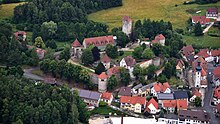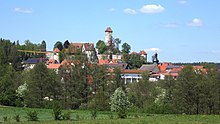Veldenstein Castle
| Veldenstein Castle | ||
|---|---|---|
|
Veldenstein Castle - general view from the north |
||
| Alternative name (s): | Neuhaus Castle | |
| Creation time : | First mentioned in 1269 | |
| Castle type : | Höhenburg, spur location | |
| Conservation status: | Receive | |
| Place: | Neuhaus an der Pegnitz | |
| Geographical location | 49 ° 37 '45.5 " N , 11 ° 32' 57.1" E | |
|
|
||
The Burg Veldenstein is a large, well-preserved medieval hilltop castle above Neuhaus an der Pegnitz at the southern end of the Veldensteiner Forst , about 50 kilometers northeast of Nuremberg in Bavaria .
History of the castle
The year Veldenstein Castle was built and the name of the builder are not confirmed. However, much points to the Bishop of Eichstätt , who in 1008 on behalf of Konrad II had border fortifications built on the northern border of his diocese.
In 1269 the castle was first mentioned in a document as "novum castrum" (new castle). At that time the castle belonged to the bishopric of Bamberg and was the administrative seat of the Bamberg bishops for the surrounding lands. In 1323 the castle was first called Veldenstein.
At first, simple farmers were bailiffs at the castle, who also owned the farms on the castle hill, the so-called castle guards. At that time the castle was hardly larger than the area of the keep . From the 14th century, nobles came to Veldenstein for the first time as representatives of the bishop. The lords of Stör, von Egloffstein and later von Wiesenthau received the administrative castle of the bishop and the office as a fief . Hans von Egloffstein built the inner castle at the beginning of the 15th century.
After Bishop Georg I von Schaumberg (1449–1475) had redeemed the castle from the Egloffsteiners, his successor Philipp von Henneberg (1475–1487) made huge expansions for the time and built the outer castle and the battlements. He made the castle the bishop's residence for the first time; As a result, every bishop came to Veldenstein at least once to receive the hereditary homage from his subjects.
The castle was strongly fortified and withstood many attacks. In the 16th and 17th centuries, the castle changed hands several times due to cessions and (re) conquests, the castle was occupied by Brandenburgers, Nürnbergers and finally in the Thirty Years War in 1632 by the Swedes, followed three years later by the Bavarians.
Finally, the Bamberg bishops resided on Veldenstein again until the castle was largely destroyed in 1708 by a lightning strike in the powder tower. The interest of the bishops waned and the ruin deteriorated more and more.
Neuhaus fell to Bavaria in 1803 as a result of secularization after the peace treaty of Lunéville with Napoléon Bonaparte and in 1805 came to the Upper Palatinate . Since the ruined castle was of no interest to Bavaria, it was sold to private individuals and again changed hands several times.
In 1861, Wolfgang Brunnhuber sold all of his holdings at Veldenstein Castle for 1300 guilders and 44 guilders on loan to the retired district court official Carl Heinrich Friedrich August May, who had been a district judge there from 1853 to 1862. Anna Sturm sold him the tower, the former upper office apartment, the main portal and all walls in 1863 for 300 guilders, so that the castle was once again in one hand. In 1863 a residential building was expanded on the castle. The grain box was replaced and a 19th century mansion was built in its place . District judge May died in the castle in 1873. His widow Anna Regina May inherited the castle together with her five children. A construction section from 1871 to 1878 under engineer GC Hennch carried out renovations, wanted to preserve the castle and provided the widow May with a construction grant to restore the tower, which was completed in 1875. In 1890 she had the building ring renovated. In 1897 she sold the castle to the medical officer Hermann von Epenstein , landowner in Berlin, for 20,000 marks. Epenstein tried to restore the castle to its former appearance and spent one million marks on the restoration by 1914. He commissioned the Nuremberg master stonemason Johann Gröschel to expand the castle; The walls, towers and gates were repaired in almost ten years of construction.

During this time, the friends of the Heinrich Göring family also lived in the manor house of Veldenstein Castle. Their sons Hermann and Albert , whose godfather was Hermann von Epenstein, went to school in Neuhaus and Velden.
After the death of her husband, the widow Elisabeth von Epenstein sold the castle in 1939 to Hermann Göring, who had meanwhile risen to the position of Reich Minister of the National Socialist regime . In the course of the “ Aryanization ” of Jewish businesses , he had previously procured Julius Fromm's market-leading condom company at a ridiculous price. Göring had the castle renovated and in 1942 a bomb-proof bunker with its own electricity, air and water supply was built under the manor house . The self-proclaimed Reichsjägermeister came regularly to hunt Veldenstein and had the Pegnitztalstrasse paved. However, he rejected the Neuhauser's wish for a bathing establishment with the words "If I could hold my ass in the Pegnitz, the Neuhausers can do that too".
In 1945, after a short battle, Neuhaus and the castle were conquered by the Americans, who took up quarters in the castle and examined it for treasures with jackhammers. The “gold rush” had broken out because of the rumor that Göring had sent the art treasures from his estate to Veldenstein during the last days of the war. But only a box with 36 old table lamps as well as wine, champagne and cognac was found.
When the Americans withdrew, up to 100 refugees were accommodated in the castle. The trace of a partition wall in the north-east tower, which is clearly visible in the parquet, also dates from this time.
In 1950 the Free State of Bavaria became the owner of the castle and placed it under monument protection .
From 1968 the facility was used by a falconry, before the local Kaiser Bräu became the tenant of the castle in 1972. The former manor house was converted into a hotel-restaurant and the castle complex was opened to the public in 1974; there are also some private apartments on the site.
Since 2002, the Veldensteiner Festival has been held at the castle every year at the end of July, with various bands playing in the castle courtyard on weekends. A medieval market is also held.
On December 31, 2012, the Kaiser Bräu lease with the Free State of Bavaria expired. The hotel and the apartments were cleared, the castle has been closed and has been vacant since then and the Free State has been looking into how it should be used in the future.
In May 2013, 300 tons of rock and parts of the castle wall fell into the valley and damaged a house. 16 residents were evacuated. The castle was closed for a total of 14 months. A viewing platform was built at the point where the rock fell. The castle should be reopened at the end of July 2014. However, it remained closed due to safety concerns. The state building authorities had obviously had investigations carried out into how the rock fall came about and identified the lack of rainwater drainage as the reason. As a result, an extensive renovation program was started, which should last until 2021. Only then can the expansion of the premises for a new use begin.
The castle is designated by the Bavarian State Office for the Preservation of Monuments as an architectural monument (D-5-74-140-2) and a ground monument (D-5-6335-0053).
literature
- G. Ulrich Großmann: Neuhaus ad Pegnitz: The Veldenstein Castle . In: Alfried Wieczorek: Excursions to archeology, history and culture in Germany, Volume 52: Nuremberg and Nürnberger Land - excursion destinations between Pegnitz and Franconian Alb . Konrad Theiss Verlag, Stuttgart 2010, ISBN 978-3-8062-2368-2 , pp. 178-181.
- Robert Giersch, Andreas Schlunk, Berthold Frhr. von Haller: Castles and mansions in the Nuremberg countryside - a historical handbook based on preliminary work by Dr. Gustav Voit . Self-published by the Altnürnberger Landschaft e. V., Lauf an der Pegnitz 2006, ISBN 978-3-00-020677-1 , pp. 288-293.
- Ruth Bach-Damaskinos, Jürgen Schnabel, Sabine Kothes: Palaces and castles in Middle Franconia. Verlag A. Hoffmann, Nuremberg 1993, ISBN 3-87191-186-0 , pp. 28-29.
- Wilhelm Schwemmer: The castle and the former Bamberger Oberamt Veldestein . In: 92nd report of the historical association for the maintenance of the history of the former duchy of Bamberg . Bamberg 1953.
- Wilhelm Schwemmer: Castle and Office Veldenstein ( series of publications of the Altnürnberger landscape, 8). Nuremberg 1961.
Web links
- Veldenstein Castle ruins (Neuhaus) on the website of the House of Bavarian History (plans, history, building history, existing buildings)
- Veldenstein Castle northeast tower









